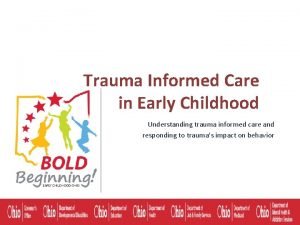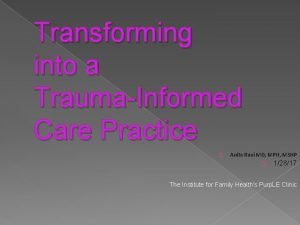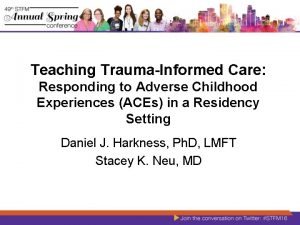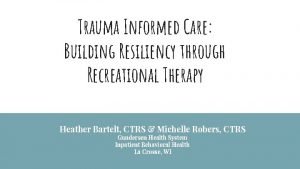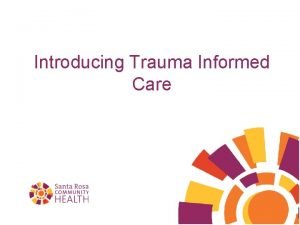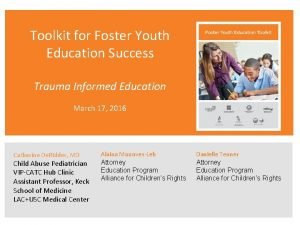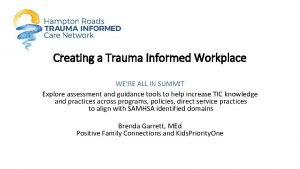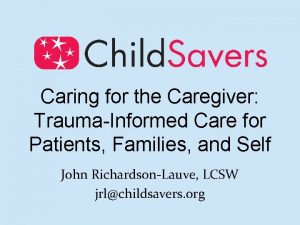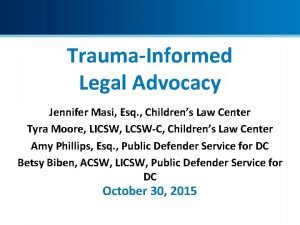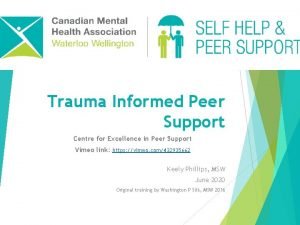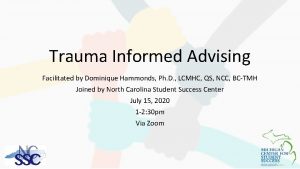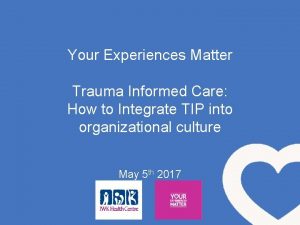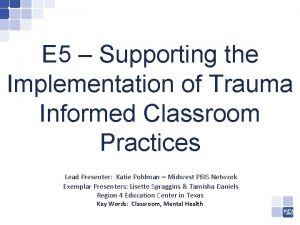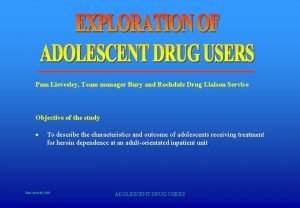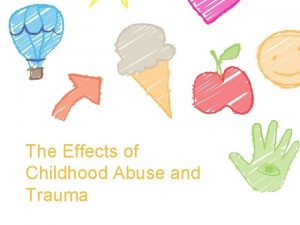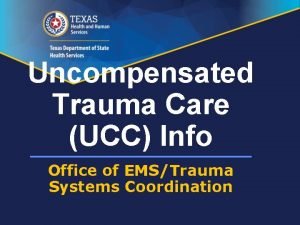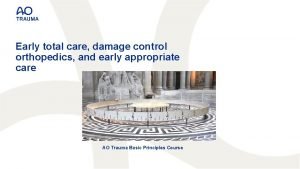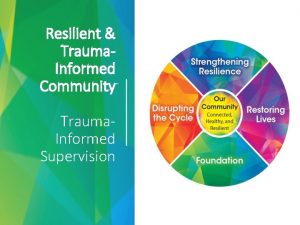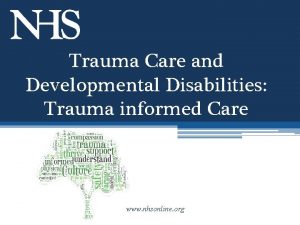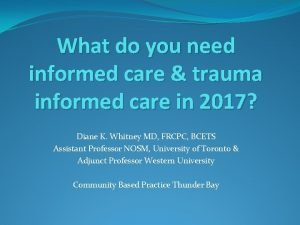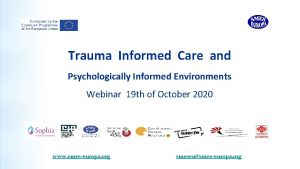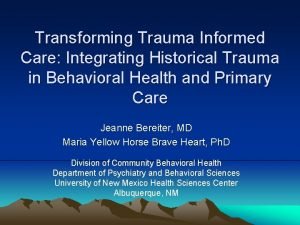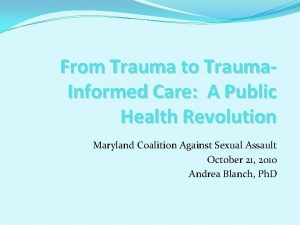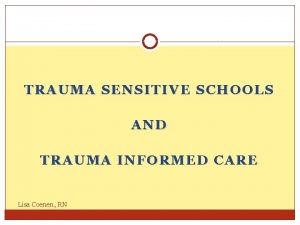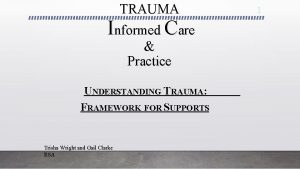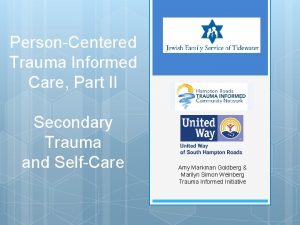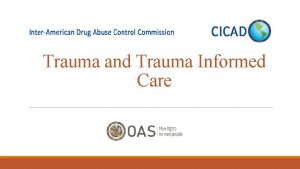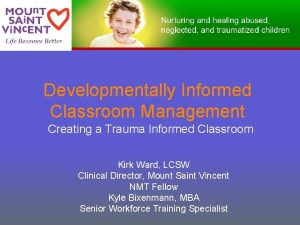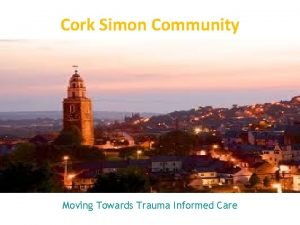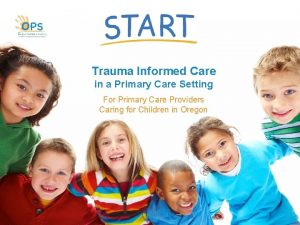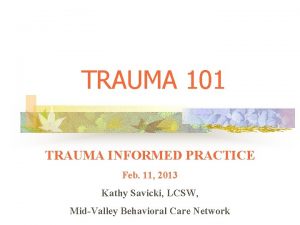Trauma Informed Care in the Community Pam Kasinetz























- Slides: 23

Trauma Informed Care in the Community Pam Kasinetz Jeff De. Santis Resources for Human Development

Objectives • 1. Describe thinking behind and importance of Trauma-Informed Care in your own words; • 2. Reflect critically about situations and challenges in your programs; • 3. Create pathways to implementing community-based Trauma. Informed Care interventions back at your own programs.

Definition of Trauma An EVENT of series of events or set of circumstances that is EXPERIENCED by an individual as physically or emotionally harmful or life threatening and that has lasting adverse EFFECTS on the individuals functioning, ability to cope and well-being

Trauma Shapes our Beliefs

The Adverse Childhood Experiences Study (ACEs)


Key Findings: ACES ARE COMMON! • 67% had at least 1 ACE • 1 in 8 had 4 or more • Four or more ACES: • 2 x’s – COPD 4 ½ x’s - Depression • 2 ½ x’s – Hepatitis • 12 ½ x’s – attempt suicide • 7 or more ACES: • Triple risk of lung cancer • 3 ½ x’s - heart disease

Trauma Informed Care Is… A Shift in Thinking from. . What’s Wrong with You!? to What Happened to You?

A program, organization, or system that is Trauma-Informed… § REALIZES the widespread impact of trauma and understands potential paths for recovery; § RECOGNIZES the signs and symptoms of trauma in clients, families, staff, and others involved with the system; § RESPONDS by fully integrating knowledge about trauma into policies, procedures, and practices § Seeks to actively RESIST RE-TRAUMATIZATION

Most Importantly… Recognizing that trauma related symptoms and behaviors originate from ADAPTING to Traumatic Experiences

Key Principles of Trauma-Informed Practices • • • Safety Trustworthiness and Transparency Peer Support and Mutual Help Collaboration Empowerment, Voice and Choice Culture, Historical and Gender Issues • Connection https: //www. samhsa. gov/samhsa. News. Letter/Volume_22_Number_2/trauma_tip/guiding_principles. html

Key Principles of Trauma-Informed Practices 1. Safety: ensuring physical and emotional safety 2. Trustworthiness: maximizing trustworthiness, making tasks clear, and maintaining appropriate boundaries 3. Choice: prioritizing consumer choice and control 4. Collaboration: maximizing collaboration and sharing of power with consumers 5. Empowerment: recognizing skills and strengths, skill building, validation 6. Connection: Connection with others heals

Trauma Informed Implementation

Trauma Informed Care Domains • Domain 1 • Domain 2 • Domain 3 • Domain 4 • Domain 5 • Domain 6 • Domain 7 Early Screening and Assessment Consumer Driven Care and Services Trauma Informed and Educated Workforce Trauma Informed, Evidenced Based Best Practices Safe and Secure Environment Community Outreach and Partnership Building Ongoing Performance Improvement

What should Trauma Informed Care in the Community look like?

Challenges • No established standards • Can’t control the environment • Can’t control the people who do control the environment • Hard to evaluate competence

Facing the Challenges • Networking • Preparing • Educating

How do we explain the concepts in layman’s terms? § REALIZES the widespread impact of trauma and understands potential paths for recovery; § RECOGNIZES the signs and symptoms of trauma in clients, families, staff, and others involved with the system; § RESPONDS by fully integrating knowledge about trauma into policies, procedures, and practices § Seeks to actively RESIST RE-TRAUMATIZATION

Trauma Informed Care for the Caregiver

Trauma Informed Care is a parallel process for staff • Safety • Trustworthiness • Choice • Collaboration • Empowerment • Connection

Self Care

Organizational Response to Self-Care • Reflective Supervision • Sharing Our Support (S. O. S) Team • Staff Safety Plans • Designated Self-Care Specialist • Mindfulness Apps / Podcasts

Conclusions and Observations
 4 r's trauma informed care
4 r's trauma informed care Trauma informed care lgbtq
Trauma informed care lgbtq Dr anita ravi
Dr anita ravi Trauma-informed care cheat sheet
Trauma-informed care cheat sheet 4 r's trauma informed care
4 r's trauma informed care Family enhancement center
Family enhancement center Tina champagne sensory modulation and environment
Tina champagne sensory modulation and environment Trauma-informed care cheat sheet
Trauma-informed care cheat sheet Trauma-informed care activities for staff
Trauma-informed care activities for staff Trauma informed care for foster youth
Trauma informed care for foster youth Trauma informed workplace
Trauma informed workplace Trauma-informed questions for clients
Trauma-informed questions for clients Jennifer masi
Jennifer masi Trauma informed peer support
Trauma informed peer support Trauma informed advising
Trauma informed advising Acessexual
Acessexual Trauma informed practice
Trauma informed practice Trauma infromed
Trauma infromed Trauma informed practice
Trauma informed practice Bury pam pam
Bury pam pam Level of care primary secondary tertiary
Level of care primary secondary tertiary What is community trauma
What is community trauma Uncompensated trauma care application texas
Uncompensated trauma care application texas Total care orthopedics
Total care orthopedics
